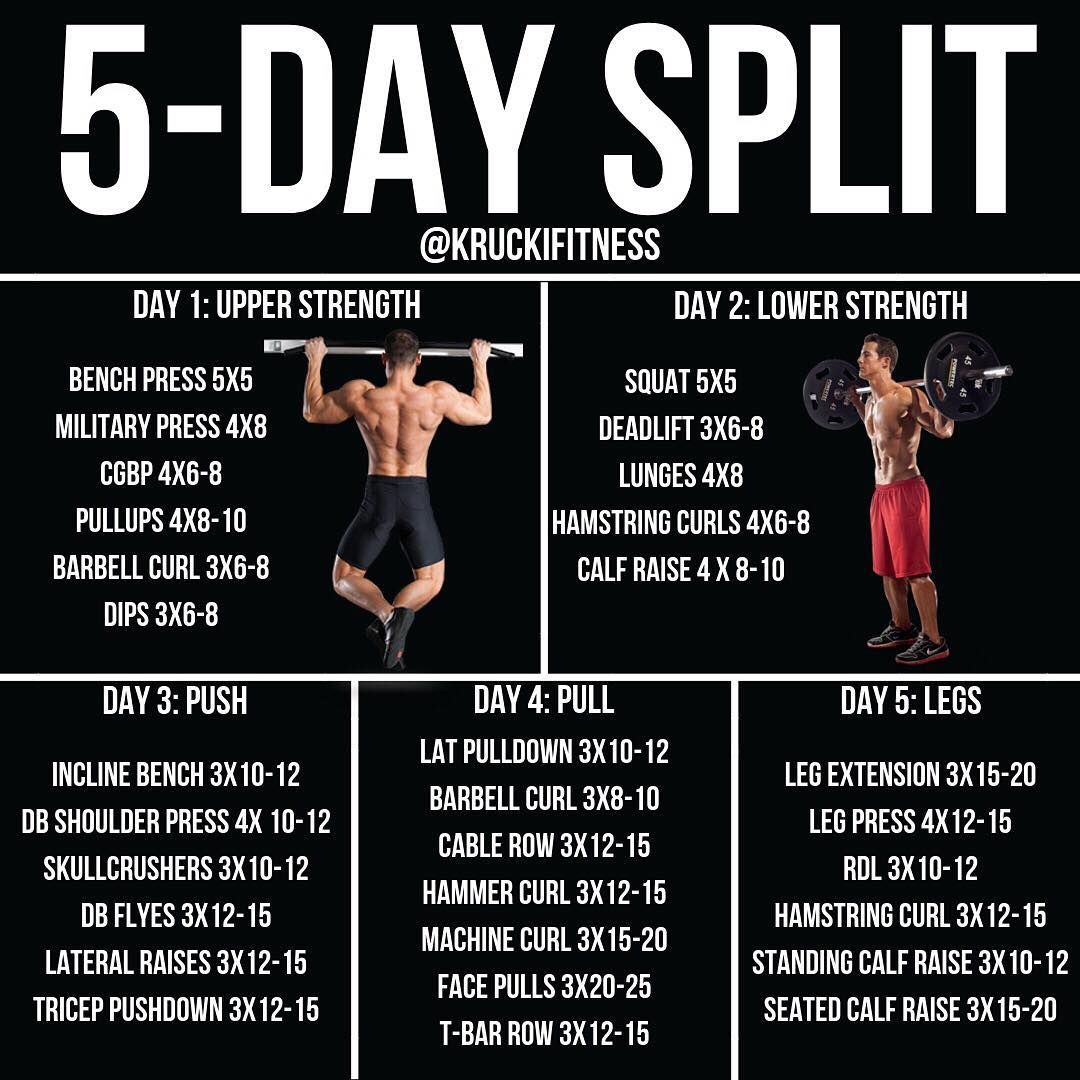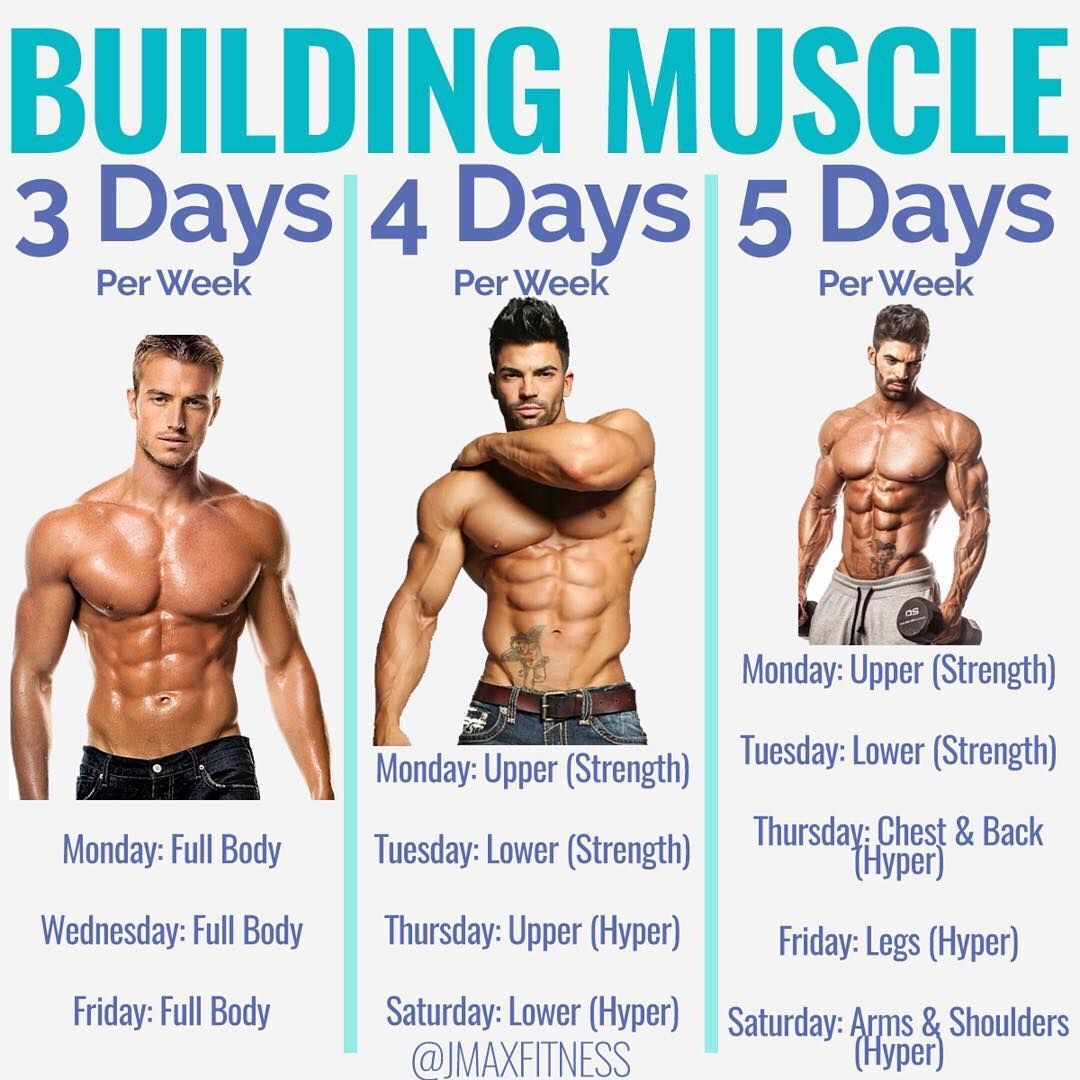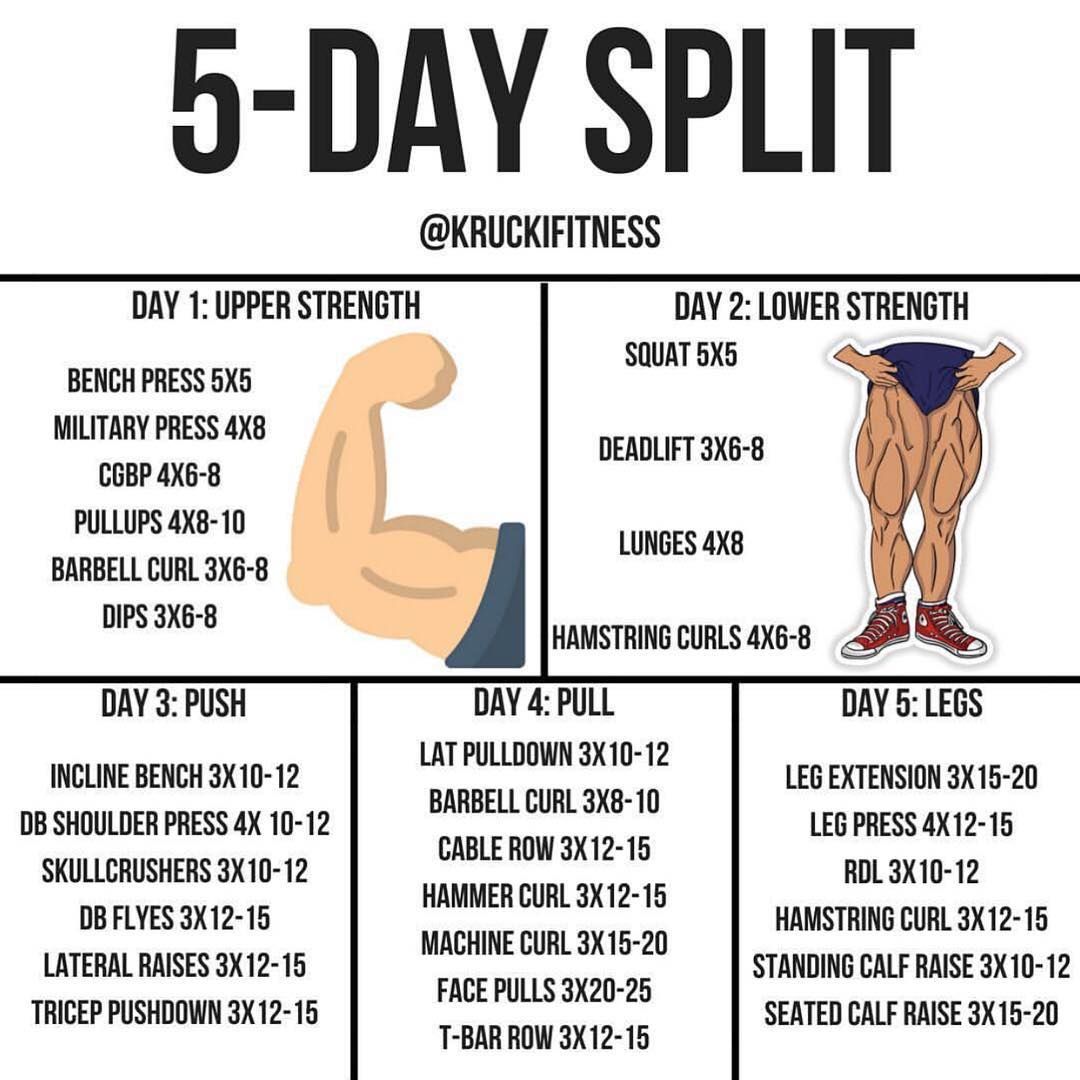Examples:
- Day 1: push — chest, shoulders, triceps.
- Day 2: pull — back, biceps, forearms.
- Day 3: legs — quads, glutes, hamstrings, calves.
- Day 4: push — chest, shoulders, triceps.
- Day 5: pull — back, biceps, forearms.
- Day 6: legs — quads, glutes, hamstrings, calves.
- Day 7: rest.
What workout split is best for arms?
You'll take the basic upper lower split. And supercharge it for massive arms. Day one you'll train the entire upper body with a focus on the chest. And shoulders.
How do you structure arm workouts?
Do 3-4 sets of each exercise with 45-69 second rests between each set.
- Bent over row - 8 reps.
- Pull ups - 8 reps.
- Cable rows - 10-12 reps.
- Hammer curls - 8 reps.
- Cable bicep curls - 10-12 reps.
What arm groups to workout together?
Next are the arms and shoulders. Because they're complementary muscle groups, it makes sense to train them together rather than on different days. You'll be using your triceps (and biceps to some degree) when training your shoulders anyway, so you won't need as much time as you would on leg day, for example.
Should I do a separate arms day?
Lastly, training arms on a separate day allows for greater concentration during each movement. The body is not pre-exhausted from training a larger muscle group before training arms, the smaller muscle group. Pay attention to strict form.
How should I space out my workouts?
Always allow at least 48 hours between sessions for muscles to recover. So, if you do a strenuous full-body strength workout on Monday, wait until at least Wednesday to repeat it. It is fine to do aerobic exercise on the days between your strength training.




High Volume workout I used to run:
— 𓄀 🌞 Sol Brah 🌞 𓄀 (@SolBrah) October 30, 2020
Push Pull Legs x Push Pull Arms in a week cycle pic.twitter.com/zW0TK0MjHT
How do you space out 2 a day workouts?
Allow at least six hours of space between moderate-intensity workouts. So, if you finish your first workout at 8 a.m., you shouldn't start your next workout until at least 2 p.m. For higher-intensity activities, allow more time between sessions.
Frequently Asked Questions
What is the 90 10 rule gym?
Experienced fitness expert and author, Steven Farmer, explains how the 90/10 Fitness program—in which you get 90 percent of your results from just focusing on the 10 percent that matter—is the only way anyone should train, especially in a world with a million things that person needs to be doing.
What is Rule 5 in workouts?
Rule 5: You don't have to break your body to achieve results
You can exercise twice a day, but you shouldn't exercise for more than an hour at a time. Stay in your own lane and compete only against yourself. The only clock you should be running on is yours.
How do I tone my lower half of my body?
The 25 best bodyweight leg exercises
- Wall squat.
- Squat.
- Wide leg open toe squat.
- Goblet squat.
- Squat into side leg lift.
- Reverse lunge.
- Stationary lunge.
- Good mornings.
How should I distribute my workouts?
Examples:
- Day 1: push — chest, shoulders, triceps.
- Day 2: pull — back, biceps, forearms.
- Day 3: legs — quads, glutes, hamstrings, calves.
- Day 4: push — chest, shoulders, triceps.
- Day 5: pull — back, biceps, forearms.
- Day 6: legs — quads, glutes, hamstrings, calves.
- Day 7: rest.
How do I group my workouts?
6-day split: Push/ pull/ legs
- Monday: Chest, shoulders and triceps.
- Tuesday: Back, biceps, abs and forearms.
- Wednesday: Legs.
- Thursday: Chest, shoulders and triceps.
- Friday: Back, biceps, abs and forearms.
- Saturday: Legs.
- Sunday: Rest.
Can you sell workout programs?
Sell workout plans
By creating pre-made workout plans for different purposes (such as 7-day challenges as well as longer, month-long programs) you can appeal to more people while still targeting some common goals. Even clients looking for a weight-loss plan won't need to pay for a full-time personal trainer!
How should you space out your workouts?
So in a two- to three-day strength plan, this means you should aim to do full-body workouts, giving yourself 48 hours in between each session to give your muscles time to recover.
FAQ
- How should I structure my workouts?
- Here's What a Perfectly Balanced Weekly Workout Schedule Looks...
- Monday: Upper-body strength training (45 to 60 minutes)
- Tuesday: Lower-body strength training (30 to 60 minutes)
- Wednesday: Yoga or a low-impact activity such as barre, light cycling, or swimming (30 to 60 minutes)
- Thursday: HIIT (20 minutes)
- How do you split up workout days?
- 6-day split
- Day 1: push — chest, shoulders, triceps.
- Day 2: pull — back, biceps, forearms.
- Day 3: legs — quads, glutes, hamstrings, calves.
- Day 4: push — chest, shoulders, triceps.
- Day 5: pull — back, biceps, forearms.
- Day 6: legs — quads, glutes, hamstrings, calves.
- Day 7: rest.
- What is the best way to split up muscle groups?
- The push/pull/legs split is probably the most efficient workout split there is because all related muscle groups are trained together in the same workout. This means that you get the maximum overlap of movements within the same workout, and the muscle groups being trained get an overall benefit from this overlap.
- How should I space out my workout days?
- Give muscles time off These tears are good, not bad: muscles grow stronger as the tears knit up. Always allow at least 48 hours between sessions for muscles to recover. So, if you do a strenuous full-body strength workout on Monday, wait until at least Wednesday to repeat it.
- Is it OK to spread out workouts throughout the day?
- Splitting your workout into several smaller ones won't harm your recovery, muscle growth, or strength gain. If anything, it will slightly improve your results. It's also great for your health. The only downside is that it can be less convenient.
- Can I split up my workout throughout the day?
- Breaking up your exercise throughout the day can be just as beneficial for your physical and mental health as doing one singular session! It's true! And the better news is: You don't even have to engage in super strenuous exercise to reap the benefits.
How to split arm workouts
| Is I space out my workouts throughout a day do I get the same result? | If you are training maximal strength, there can be advantages to spacing sets out throughout the day. On the other hand, if you are trying to develop endurance, spreading out sets is the opposite of what you want to do. |
| What is the 2 day rule for gym? | With this in mind, the two-day rule simply involves not allowing yourself to skip a new habit for two days in a row. So, if you skipped going to the gym or reading for 30 minutes one day, you'd pick it back up the next. |
| How do you distribute workouts? | 6-day split
|
| How do you structure a home workout? | Create Your Own Workout
|
| What is the most effective way to workout at home? | 7 simple functional fitness exercises
|
| How do you distribute cardio and strength training? | Variety is the key to keep going. Ideally one should perform cardio and strength training on alternate days. A 40 minutes session of cardio and strength training on alternate days are enough for weight loss. |
- How should workouts be divided?
- If you plan on working out one to three days a week, you'll do best to plan out a full-body workout split. On the other hand, you'll want to use a push-pull or upper-lower split if you're strength training four days a week, says Taylor. Then, it's time to create each of your workouts for the week.
- What is the most effective workout split?
- If you are past the beginner's stage and want to gain muscle, one of the best body part splits you can use to accomplish this is the push/pull/legs split routine. The push/pull/legs split is one of the simplest, most enduring and popular workout routines there is.
- Is it better to do a split workout?
- While full-body workouts have a wide range of benefits, a split workout regimen may be the best choice if your goal is to increase mass. Because a split workout allows for increased intensity, volume, and recovery time for each muscle group, it is more conducive to building muscle mass.
- How do you split a workout example?
- Example Workout Routine
- Monday: Chest and triceps.
- Tuesday: Back and biceps.
- Wednesday: Legs and shoulders.
- Thursday: Rest.
- Friday: Chest and triceps.
- Saturday: Back and biceps.
- Sunday: Legs and shoulders.
- Example Workout Routine
- What is a 2 split workout?
- One such method that has gained popularity in recent years is the "double-split workout." This training approach involves dividing your daily workout routine into two separate sessions, offering a unique way to enhance muscle growth, improve endurance, and optimize performance.
- Which split is best for beginners?
- A full-body split is a great option for beginners or people who have limited training time. However, the exercise selection can be too narrow for some, and if you want to train more than three days per week, you should pick another split.
